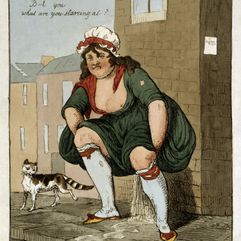

Isaac Cruikshank
1764 - 1811
Isaac Cruikshank was a Scottish painter and caricaturist, known for his social and political satire.
Biography
Cruikshank was the son of Andrew Crookshanks (c. 1725 - c. 1783), a former customs inspector, dispossessed for his role in the Jacobite rising of 1745 originally from Edinburgh, and Elizabeth Davidson (born c. 1725), the daughter of a gardener. He was born on 5 October 1764 in Edinburgh, where he was baptised on 14 October 1764. Isaac grew up in New North Kirk parish in Edinburgh after his family moved there. He was the youngest child, and was interested in all sorts of hobbies including sports and music. Isaac studied with a local artist, possibly John Kay (1742-1826).
In 1783, Cruikshank left Scotland to travel to London with his master. There he married Mary MacNaughton (1769-1853) on 14 August 1788. The couple had five known children, two of whom died in infancy. A daughter, Margaret Eliza (1808-1825), a promising artist, died at the age of eighteen of tuberculosis. Their sons Isaac Robert Cruikshank (1789-1856), and George Cruikshank (1792-1878), also became artists.
Cruikshank's first known publications were etchings of Edinburgh "types", from 1784. His first caricature etching called Scotch Eloquence was of Edinburgh characters. He produced illustrations for books about the theatre, did the frontispiece for Witticisms and Jests of Dr. Johnson (1791), and illustrated George Shaw's extensive General Zoology (1800-26). His water colours were exhibited, but in order to make a living, he found it more lucrative to produce prints and caricatures. He was responsive to the marketplace but firm in his dislikes of Napoleon and Britain's home-grown political radicals, including, for example, the members of the London Corresponding Society and the Society of the Friends of the People. He and James Gillray developed the figure of John Bull, the nationalistic representation of a solid British yeoman. His Olympic games or John Bull introducing his new ambassador to the grand consul and Boney at Brussells (both from 1803) contrast an implied European capitulation and British defiance under the threat of invasion.
Near the start of his fame in 1789, Cruikshank produced several watercolours adapted from his earlier drawings, and was on exhibition at the Royal Academy. Publisher John Roach was a friend and patron. Cruikshank later also worked with print dealer S. W. Fores and Johnny Fairburn. He also collaborated with G. M. Woodward, and later, with his son George. (See also G.S. Tregear.) He also etched and designed lottery tickets and the song-heads of musical scores.
Cruikshank died of alcohol poisoning at the age of forty-six as a result of a drinking contest, of which he was declared the winner. He is buried near his home in London.
Text courtesy of Wikipedia, 2025








